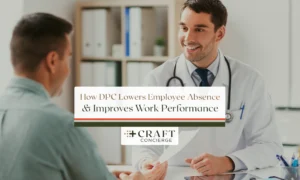Choosing a healthcare plan for your family shouldn’t feel like solving a puzzle with missing pieces. You deserve care that’s there when your child spikes a fever at midnight, affordable when life throws you unexpected curveballs, and flexible enough to actually fit into your real, busy life.
For many families like yours, that choice often comes down to Direct Primary Care (DPC) versus High Deductible Health Plans (HDHPs) – two completely different approaches to healthcare that each promise different kinds of peace of mind.
Here’s what the numbers tell us: HDHPs now cover over 51% of private industry workers enrolled in employer-sponsored health plans, largely because those lower monthly premiums look so appealing on paper. But here’s the reality many families discover too late – they also bring higher out-of-pocket costs that can cause you to think twice before taking your child to the doctor. In fact, 40% of Americans say deductibles are the main reason their healthcare costs feel overwhelming, and families managing chronic conditions often find themselves caught between needing care and being able to afford it.
DPC offers something refreshingly different: a membership-based model with transparent monthly pricing, unhurried appointments, and same-day access – all without the headache of insurance billing. It’s designed around the everyday healthcare moments that families actually experience. And families are taking notice: the DPC market is projected to grow from $70.42 billion in 2025 to $92.51 billion by 2029, driven by families seeking preventive care, cost transparency, and genuine relationships with their healthcare providers.
In this guide, we’ll walk through both models together – from real costs and care access to flexibility and long-term impact – so you can make a decision that truly serves your family’s unique needs and gives you confidence in your healthcare choices.
What Is Direct Primary Care (DPC) and How Does It Work?

Direct Primary Care (DPC) is like having a family doctor who actually knows your family. You pay a straightforward monthly fee in exchange for continuous access to care, without the maze of insurance billing, surprise co-pays, or claim denials that can turn a simple doctor’s visit into a financial stress.
Here’s what this looks like for your family’s daily life:
- You pay one predictable monthly fee instead of worrying about per-visit charges or wrestling with insurance paperwork
- You can schedule unlimited appointments – whether your teenager needs to be seen in person or your toddler just needs a quick virtual check-in
- Visits are actually long enough for your doctor to listen, understand your concerns, and give you the attention your family deserves
- You can reach your provider directly – text or call when you’re worried, even after regular office hours
- Services feel comprehensive and personal – from managing ongoing health conditions to urgent care, preventive screenings, pediatric checkups, lab coordination, and wellness guidance that fits your family’s lifestyle
The heart of DPC is making healthcare feel human again – simple, accessible, and built around genuine relationships. Instead of rushing through appointments or waiting weeks to be seen when your child is sick, your family gets care that actually adapts to your real life, not the other way around.
What Is a High Deductible Health Plan (HDHP)?

A High Deductible Health Plan (HDHP) is essentially a trade-off: you pay lower monthly premiums in exchange for taking on higher out-of-pocket costs when your family actually needs medical care. It’s designed for families who want to minimize monthly expenses and hope they won’t need frequent medical visits.
Here’s what qualifies as an HDHP in 2025, according to IRS requirements:
- Deductible must be at least $1,650 for an individual or $3,300 for a family
- Out-of-pocket maximum can reach $8,300 for individuals or $16,600 for families
Many families choose HDHPs because they unlock access to Health Savings Accounts (HSAs) – tax-free accounts that let you save money for medical expenses like prescriptions, dental work, glasses, and those deductibles. Only HDHPs qualify for this benefit.
What HDHPs typically cover upfront:
- Preventive services like immunizations, screenings, and wellness counseling (often with no co-pay)
- Emergency care, surgeries, hospital stays, and specialist visits once you’ve met your deductible
What you’ll likely pay out-of-pocket until you meet that deductible:
- Regular doctor visits for illnesses or concerns
- Lab tests and imaging when your child needs them
- Non-emergency procedures that your family might need
The challenge many families face is that when you’re worried about your child’s health, that deductible can feel like a barrier between you and the care you need.
What’s the Real Difference Between DPC and HDHP for Families?
DPC and HDHPs serve completely different purposes in your family’s healthcare journey. Here’s how each model supports (or sometimes limits) the kind of care your family actually needs:
| Aspect | Direct Primary Care | High Deductible Health Plan |
| Monthly Cost | Flat monthly fee (typically $99-$150 per person) | Lower premiums, but high deductibles and out-of-pocket costs |
| Routine Visits | Unlimited visits, no co-pays | Paid out-of-pocket until deductible is met |
| Preventive Care | Included and easily accessible | Covered, but often limited to specific screenings |
| After-Hours Access | Direct messaging and calls to your doctor | Typically not available |
| Billing Simplicity | No insurance billing or paperwork | Requires claims, billing cycles, and pre-authorizations |
| Wait Times | Same-day or next-day appointments | Often delayed due to provider schedules and network limitations |
| Care Continuity | Built-in relationship with your family doctor | Depends on network changes, referrals, and plan limitations |
| Specialist Access | Coordinated thoughtfully by your DPC provider | Covered after deductible, often with additional copays |
Families who want daily support, unhurried visits, and direct access to their doctor often find DPC transforms their healthcare experience. Those primarily focused on catastrophic coverage or maximizing HSA benefits might lean toward HDHPs.
Can You Use DPC and an HDHP Together?

Absolutely, and many savvy families are discovering this combination gives them the best of both worlds. Here’s how this partnership works beautifully:
DPC handles your everyday family health needs – those middle-of-the-night fevers, routine checkups, managing ongoing conditions, and all the day-to-day health questions that come with raising a family.
HDHP provides your safety net for major events – surgeries, emergency room visits, or hospital stays get covered once you reach your deductible.
You still get HSA benefits – the IRS allows HSA contributions with HDHPs, even when you’re also part of a DPC practice, as long as the DPC structure meets compliance requirements (and many do).
Budgeting becomes refreshingly predictable – you know exactly what you’re paying for DPC each month, and you can strategically use your HSA funds for those bigger, less frequent expenses like specialist visits or imaging.
This combination offers families something precious: the confidence that routine care is always within reach, while knowing that life’s bigger medical surprises are still covered. It’s healthcare security that actually makes sense.
Which Model Saves Families More Money Over Time?
Understanding the real costs helps you see which approach truly serves your family’s financial wellbeing, both today and in the years ahead.
Let’s walk through two realistic scenarios:
Scenario A: DPC + HDHP Combination
- DPC membership: $150/month ($1,800/year)
- HDHP premiums: ~$300/month ($3,600/year)
- Total base cost: $5,400/year
- HSA contributions reduce your taxable income
- Prevents costly urgent care or ER visits for minor issues that DPC can handle
Scenario B: Traditional Insurance with Co-pays
- Premiums: ~$900/month ($10,800/year)
- Co-pays: $20–$60 per visit (which add up quickly with children)
- Deductibles: $3,000+ in many plans
- Out-of-network or surprise bills can still blindside you
Additional factors that impact your family’s real costs:
HDHPs can create genuine financial stress when family members delay needed care due to cost concerns. DPC offers complete price transparency with no billing surprises – you know exactly what you’re paying for, when.
For families with young children or anyone managing ongoing health conditions, the frequent doctor visits that DPC includes often make it the more affordable and practical choice. You’re not calculating the cost of each visit or worrying about whether that concern is “worth” a co-pay.
In our experience, most families using DPC save significantly by avoiding inflated insurance billing practices while getting timely, direct care that prevents small issues from becoming expensive complications.
What Are the Pros and Cons of Each Option?
Every family has different priorities and circumstances when it comes to healthcare. Here’s an honest look at the main strengths and challenges of each approach:
| Plan Type | Pros | Cons |
| Direct Primary Care (DPC) | • Unlimited doctor visits with no co-pays • Easy, direct communication with your provider • Same-day or next-day scheduling • Transparent, predictable monthly pricing • Personalized, long-term care relationships for your whole family | • Doesn’t include emergency or hospital care • Requires separate coverage for major medical events • May need careful structuring for HSA compatibility |
| High Deductible Health Plan (HDHP) | • Lower monthly premiums • Comprehensive coverage for major medical events • HSA contributions offer valuable tax-free savings for qualified expenses | • High out-of-pocket costs when your family needs care • Routine doctor visits aren’t covered until you meet that deductible • Many families delay or skip needed care due to costs • Less continuity and relationship-building with providers |
Which Option Is Right for Your Family?
If you’re still weighing these options, consider how each aligns with your family’s real life and values:
DPC may be your family’s best fit if…
- You have young children who seem to need medical attention frequently
- You want easy, stress-free access to a provider who truly knows your family
- You’re exhausted by surprise medical bills and confusing insurance statements
- You value same-day visits and being able to reach your doctor directly when you’re concerned
HDHP may work better for your family if…
- Your family members are generally healthy and rarely need medical care
- Reducing monthly insurance premiums is a top financial priority
- You’re disciplined about contributing regularly to an HSA
- You have substantial savings set aside for unexpected medical expenses
Take a moment to reflect on these questions:
- How often does your family actually visit the doctor each year?
- Do you want more control and predictability in how and when you access care?
- Are you financially prepared to handle large medical expenses out of pocket without stress?
- What would peace of mind look like for your family’s healthcare?
Your honest answers to these questions can guide you toward the option that brings more confidence and better care to your household.
Ready for a Smarter, Simpler Way to Care for Your Family?

If DPC resonates with the kind of healthcare experience you want for your family, Craft Concierge is here to support you. We offer membership-based care designed specifically for families who want more access, deeper relationships with their healthcare providers, and complete transparency in pricing.
Sign up today or explore our membership options and discover how Craft Concierge can support your family’s health with care that truly works around your life, not the other way around.




